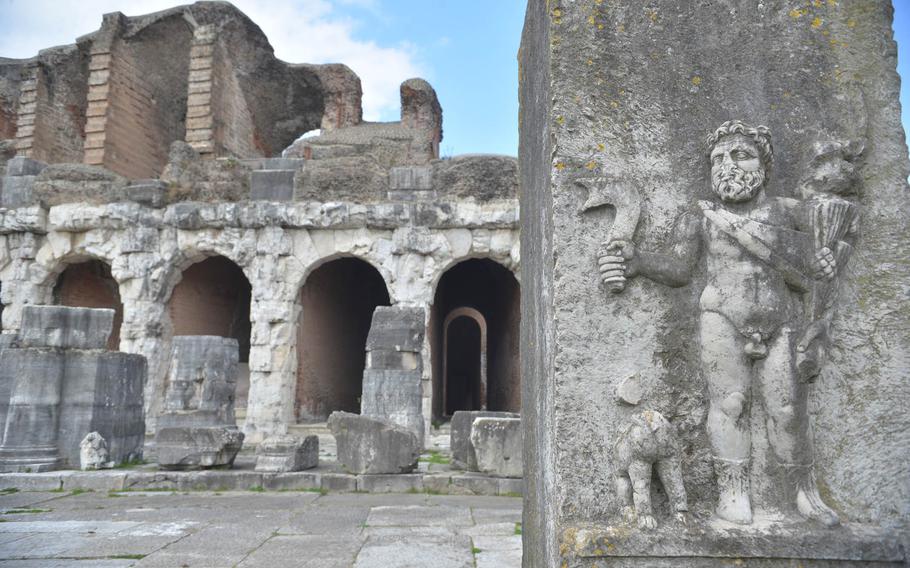
A sculpture in relief is visible on a pillar outside the Roman amphitheater of ancient Capua, in the modern town of Santa Maria Capua Vetere, Italy, just north of Naples. Built in the first century as a venue for gladiator competitions, the stadium was the second largest in ancient Rome after the Colosseum. (Steven Beardsley/Stars and Stripes)
It’s still impressive some 2,000 years later, from its intact brick arches to the dark warren of underground passages.
But the ancient Roman amphitheater in this southern Italian city near Naples is also noteworthy for what it replaced when it was built in the first century A.D. — the combat arena once stalked by Spartacus, the famed gladiator whose massive slave revolt threatened Rome itself.
A short drive from the U.S. Navy base, the site offers a compelling look at gladiator culture and one of history’s most famous fighters.
Only the bones of the amphitheater remain today, but they carry the echo of ancient spectacle. Built during the reign of Augustus and restored by later emperors, the stadium was the second-largest in ancient Rome after the Colosseum, rising to 140 feet and packing in 60,000 spectators.
They came for the gladiators, enslaved combatants who fought for their lives against both man and animal. Gladiators were dressed according to their origins — Dacians (from an area around modern-day Romania) marked by their curved swords, and Thracians (from an area near modern-day Bulgaria and Turkey) by their bronze face masks — and organized according to the theme of the fight. As in the Colosseum, the floor could be flooded for “naval battles” fought by gladiators.
The guts of the Capua amphitheater were below ground, where combatants were held before entry into the arena and animals restrained before being raised via elevators into the fight above. That lower level is now off limits, unfortunately, although parts are still visible from above. The trap doors are also still evident in the infield, which is also closed to the public.
There’s still a lot to experience. Many of the stadium’s concourses are intact. Ancient workmanship is visible in fluted pillars, engraved cornices and statuary. Several of the columns that propped the outer concourses loom over the entryway.
Just outside the amphitheater is the modest gladiator museum, which preserves some of the stadium’s decorative pieces and offers a scale model of the amphitheater past and present. A life-size mock-up of gladiator battle shows combatants attacking one another to the roar of spectators.
It was into this brutality that slave Spartacus was brought in the first century B.C. Born in ancient Thrace, he was believed to have fought with the Roman auxiliaries before being put into bondage.
Spartacus entered gladiator training in Capua. He never fought in the Augustan arena, erected a century after his death, but in the smaller one that it replaced. Nearly all of that stadium is gone, save for the foundations of an outer wall, just outside the amphitheater perimeter.
Spartacus and a group of gladiators rebelled from Capua in 73 B.C., gathering weapons and retreating to Mount Vesuvius to recruit other slaves. They raised an army, gathering nearly 100,000 fighters. Coming down from the volcano, they defeated two Roman legions and opened a path to cross the Alps for a possible return to their homelands. They instead headed south, for reasons still debated by historians, where they again met Roman legions on the battlefield.
Spartacus was killed in battle in 71 B.C. in Lucania, south of Naples along the coast, and his army was defeated. Survivors suffered terribly for their rebellion — Roman leaders crucified 6,000 of them along the Appian Way, the ancient road leading into Rome from the south.
Their revolt came to be known as the Third Servile War, and while it sparked change to gladiatorial training across Rome, it didn’t quell blood lust for the games. They would instead grow in size and spectacle, producing amphitheaters like the one in Capua.
beardsley.steven@stripes.com Twitter: @sjbeardsley
Address: Anfiteatro di Capua (the Capua amphitheater) in Santa Maria Capua Vetere is located at Piazza I Ottobre, 81055 Santa Maria Capua Vetere NA, Italy
Hours of admission: Tuesday through Sunday, 9 a.m. to one hour before sunset
Cost of entry: 2.50 euros
Food: A café and gift shop are on site.
For more information: +39 0823-798864